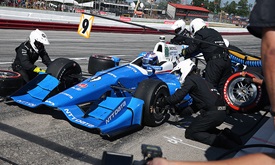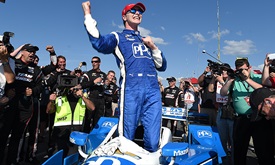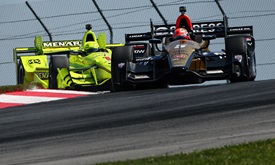Some want lapped-car rule revisited after Mid-Ohio
JUL 31, 2017
We'll never know if Verizon IndyCar Series fans were robbed of a late battle for the win in the Honda Indy 200 at Mid-Ohio, but a couple of drivers certainly think so and they'd like to see things changed to prevent the same situation from occurring again.
It happened on the restart with 19 laps to go Sunday after a full-course caution thrown four laps earlier for a spin by rookie Ed Jones in the No. 19 Boy Scouts of America Honda.
As the green waved, Esteban Gutierrez, another rookie and Jones’ teammate at Dale Coyne Racing, was a lap down to leader Josef Newgarden but positioned on track between Newgarden and pursuers Will Power and Graham Rahal. Gutierrez made no attempt to stay out of the way of the battle for the lead, and even tried to outbrake Newgarden into a corner and unlap himself.
That had Power suggesting changes are needed to the Verizon IndyCar Series rulebook to ensure back markers don't have too much influence on the outcome of races.
“It's actually not Gutierrez's fault — the rules for INDYCAR are kind of ridiculous, that the team would tell him to stay and push and he's not even in the lead,” said Power, who ended the day in second place in the No. 12 Verizon Team Penske Chevrolet.
“It ruined probably a very good battle at the end because Josef was on (the harder Firestone primary) black tires and we (Power and Rahal) were on (the softer alternate) reds.”
Rahal, who finished third, focused on the fact that Gutierrez tried so hard to overtake Newgarden just after the green flew that he locked his front tires and could have caused a disastrous accident.
“I would say Gutierrez was damn close to taking out the leader, I'm sure you saw it,” said Rahal, who finished third in the No. 15 Steak ‘n Shake Honda. “That's just ridiculous, honestly. We'll talk about it behind closed doors. I think everybody needs a little bit of a shakeup here with just the respect between drivers, but we'll go from there.”
The issue of lapped cars has been a topic of conversation and controversy before, and changes were made to help mitigate their influence late in races. For example, before the Mid-Ohio race in 2013, the Verizon IndyCar Series changed the rules so all lapped cars are moved to the back of the field on restarts with 15 laps or fewer to go. On Sunday, that rule didn't apply because the restart happened with 19 laps remaining.
The rulebook further stipulates that a lapped car will not be ordered to move aside unless it is down a lap to the entire field. Since Gutierrez was lapped only by Newgarden at that point, he didn’t have to yield his position to Power, Rahal or anyone else. He also had every right to attempt to pass Newgarden and get back on the lead lap.
After taking his second consecutive win, new championship points leader Newgarden talked about the issue of lapped cars. The driver of the No. 2 PPG Automotive Refinish Team Penske Chevrolet also contended it's a topic that should be discussed — again.
“Per the rules, (Gutierrez) has every right to actually try and pass me. It's not against the rules. It's not against what we do right now in INDYCAR,” Newgarden said. “So, there's really nothing wrong that he did, but is that the right procedure to have? I don't know anymore.”
The drivers' honest reactions after the race is a testament to the Verizon IndyCar Series, which, unlike many others, actually allows its competitors to speak their minds as long as it remains respectful. It allows the series to get raw input from the drivers on ways to improve the racing and safety.
Interestingly, changing the rules about back markers wasn't the only bone of contention among drivers at Mid-Ohio.
The topic of closing the pit lane during a full-course caution to pack the field behind the pace car also came up. It’s been a hot-button issue for years, especially after a few drivers – including Rahal – were caught out by a yellow two weeks ago in Toronto. Coincidentally, the yellow that ruined the day for Rahal and a few others ultimately handed the win to Newgarden, who had pitted just before the caution flag flew in the Honda Indy Toronto.
Power insisted that closing pit lane under caution penalizes the drivers who do a good job of delivering pace and saving fuel, while those who need to pit earlier are rewarded when a caution comes out. He feels the series should reconsider the rule.
“(Those who don't pit before the caution) literally get a drive-through penalty, and that's what's wrong with closing the pits on the yellow,” he said. “I think the field is competitive enough now to make it fair. It's a total lottery for who's in the pits. Total lottery.”
Rahal, who went from a possible win to fighting to finish in the top 10 at Toronto after the inopportune yellow, agreed that the timing of a caution and the luck — good or bad — that comes with it shouldn't determine the outcome of a race or a Verizon IndyCar series title.
“As Will said, this championship is too competitive for a race to be decided like Toronto, in my opinion,” Rahal said.
“That's why I was pretty hot after the race. The championship is too close for that to play a role. Today, luckily it was OK because we could have gone another lap to turn and decided not to. Thank God.”



















